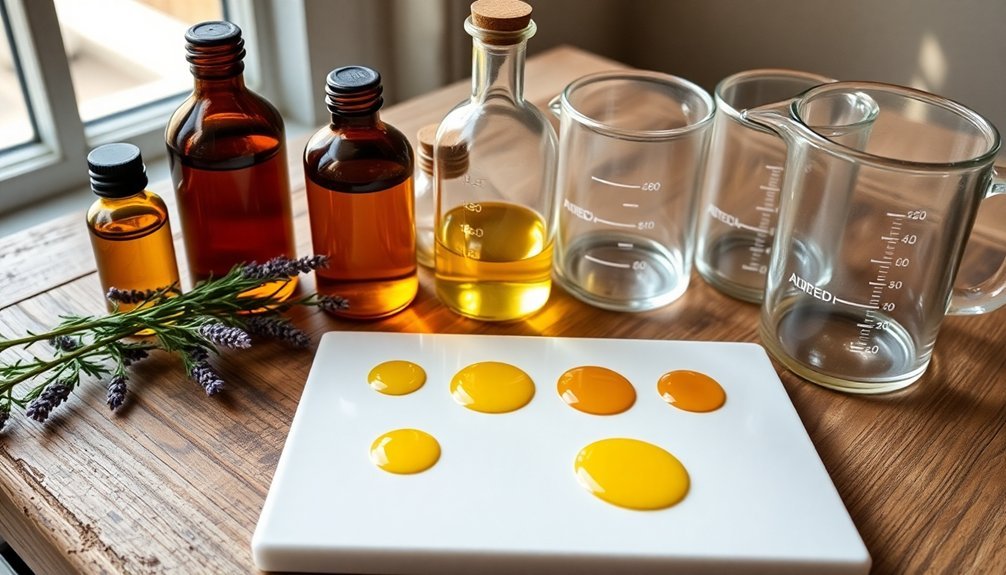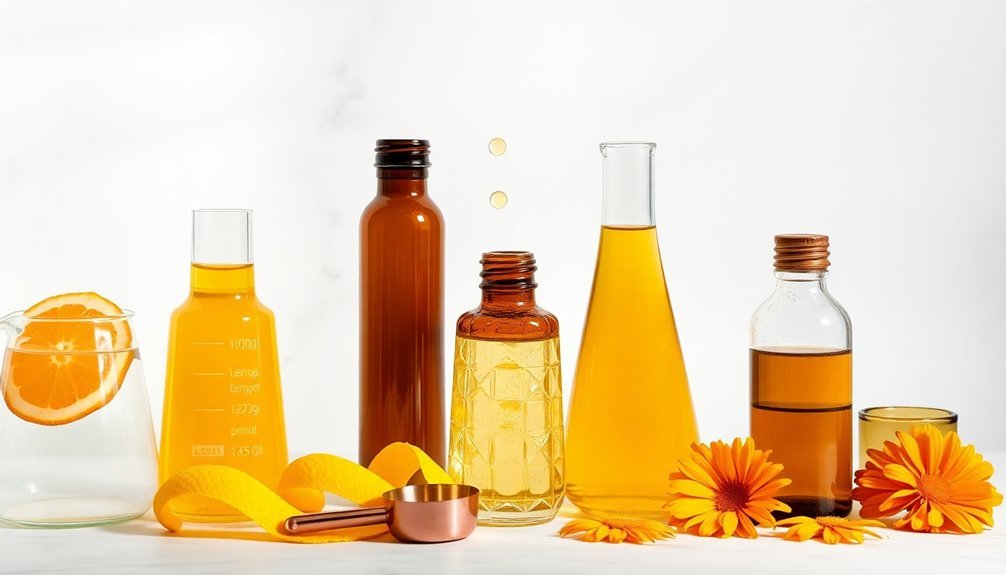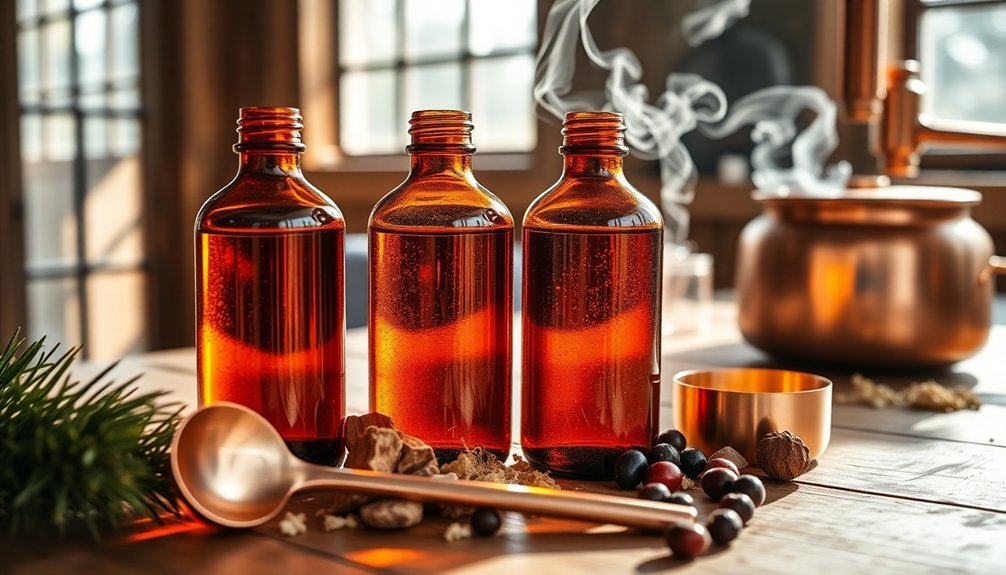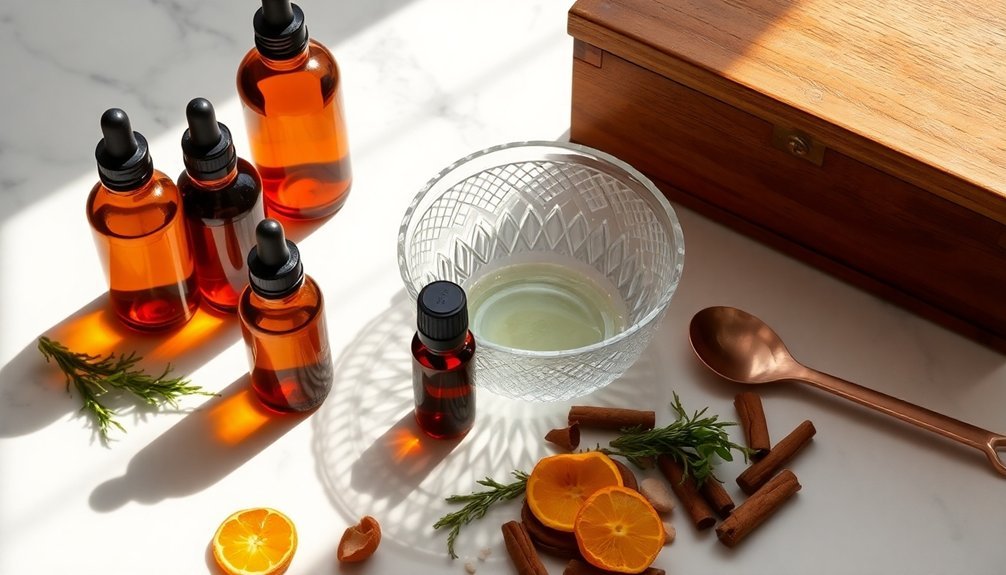Create professional-quality soaps by combining essential oils in strategic proportions. You'll achieve superior results with proven blends like lavender-spearmint (5:3), orange-vanilla (1:2), and grapefruit-geranium (1:1). For lasting scents, anchor light top notes with base oils like patchouli or cedarwood using a 50-25-25 ratio. Start with 0.7 ounces of essential oils per pound for cold-process soaps, and 0.3 ounces for hot-process. These expert combinations reveal a world of aromatic possibilities.
Selecting Base Notes for Long-Lasting Soap Fragrances

When crafting long-lasting soap fragrances, selecting the right base notes forms the foundation of your scent profile. You'll want to focus on essential oils that evaporate slowly, providing depth and staying power to your soap creations.
Dark Patchouli's rich aroma makes it a stellar base note choice, though it'll cost you between $45-70 per pound. You can blend it beautifully with citrus and floral scents.
Patchouli delivers lasting depth to soap fragrances, serving as an exceptional base note despite its premium price point.
Cedarwood's warm, woodsy character works wonderfully as a base note, especially when you pair it with lighter scents like lavender.
For maximum scent retention in your soapmaking, consider incorporating vetiver or frankincense. These essential oils offer earthy, resinous qualities that anchor your fragrance blends.
While quality base notes might cost more, they're worth the investment for their superior performance and longevity in your finished soaps.
Balancing Floral and Herbal Essential Oil Combinations

Creating harmonious floral-herbal combinations requires a delicate balance of essential oils to achieve the perfect soap fragrance.
You'll find success using a 50/50 ratio of floral to herbal oils, which lets each scent shine without overwhelming the other. Lavender and rosemary make an excellent starting point, with lavender's soft floral notes complementing rosemary's herbaceous character.
- Blend lavender (50%) with clary sage (25%) and patchouli (25%) for a well-rounded fragrance
- Pair clary sage with bergamot to create a warm, citrusy-floral balance
- Use 1 ounce of essential oils per 1.5 pounds of soap for lasting scent
- Experiment with different floral-herbal ratios to find your signature blend
- Consider complementary scent profiles when selecting your oils
These combinations will help you create sophisticated, long-lasting fragrances that appeal to diverse preferences.
Citrus-Based Blends for Invigorating Bath Experiences

When you're ready to create energizing bath soaps, you'll find citrus-based essential oils offer remarkable versatility, from Litsea Cubeba's grassy notes to Folded Lemon's bright intensity.
You can craft a long-lasting morning blend by combining 50% Litsea Cubeba with orange, bergamot, and a touch of basil for herbal depth.
The strategic mix of sweet and tart citrus oils, anchored by Litsea Cubeba's staying power, guarantees your soap maintains its invigorating scent throughout use.
Fresh Morning Citrus Mix
The art of crafting a Fresh Morning Citrus Mix lies in selecting the perfect combination of essential oils to invigorate your bathing experience.
You'll find that blending Litsea Cubeba, Folded Lemon, and Bergamot creates vibrant scents that'll transform your morning routine.
- Litsea Cubeba provides a lasting citrus base with grassy undertones
- Folded Lemon adds a bright, pure citrus note
- Bergamot contributes a sweet, complex depth
- The 50-25-25 ratio guarantees perfect balance
- Cost-effective options range from $30-$185 per pound
When you're formulating your citrus oils blend, start with Litsea Cubeba as your foundation.
Its uplifting properties work synergistically with other citrus oils to create an energizing soap that'll wake up your senses and start your day right.
Balancing Sweet With Tart
Building on the invigorating qualities of citrus blends, you'll discover endless possibilities when balancing sweet and tart notes in your soap formulations. You'll find that citrus essential oils are cost-effective, ranging from $30-$100 per pound, while offering powerful aromatic qualities. When crafting your essential oil blends, consider these balanced combinations for ideal soapmaking results:
| Sweet Note | Tart Note |
|---|---|
| Orange | Litsea Cubeba |
| Bergamot | Folded Lemon |
| Sweet Lime | Peppermint |
| Mandarin | Rosemary |
| Tangerine | Wild Lime |
The ratio of citrus oils matters greatly in achieving the perfect balance. Try a 2:1 ratio when combining sweet with tart notes to create invigorating scents. These blends work exceptionally well with woodsy or herbal undertones, allowing you to develop complex, long-lasting fragrances that transform the bathing experience.
Long-Lasting Citrus Combinations
Creating long-lasting citrus combinations requires strategic pairing of essential oils that complement and enhance each other's staying power.
You'll find that blending Litsea Cubeba with Folded Lemon creates a vibrant, lasting scent that won't fade quickly in your soap. At a usage rate of 0.7 oz per pound, these citrus essential oils deliver superior scent retention while remaining cost-effective.
- Combine Litsea Cubeba, Lemon, and Bergamot for an energizing morning soap
- Mix citrus scents with herbal notes for complex, lasting combinations
- Use folded citrus oils for better staying power in cold process soapmaking
- Keep costs manageable with these affordable essential oil blends
- Achieve perfect scent retention by following recommended usage rates
These bright, invigorating blends work particularly well for morning shower soaps, offering both aromatherapeutic benefits and excellent scent performance.
Therapeutic Properties of Woodsy Oil Mixtures

Deeply rooted in aromatherapy traditions, woodsy essential oils bring powerful therapeutic benefits to soap formulations. You'll find that cedarwood essential oil and its woodsy companions offer unique grounding properties that can transform your therapeutic blends into calming masterpieces.
These oils are particularly effective when you're seeking to create balanced fragrance blends that soothe both mind and body. When you combine woodsy essential oils with citrus or herbal scents, you'll create complex aromas that support skin health while delivering emotional benefits.
The sesquiterpenes in these oils work to reduce anxiety and promote relaxation, while their anti-inflammatory properties benefit various skin types. You can count on oils like patchouli to add depth to your blends, creating a warm and comforting experience that enhances your soap's therapeutic value.
Seasonal Essential Oil Blends for Year-Round Appeal

You'll find endless possibilities by matching your essential oil combinations to the changing seasons, from crisp winter blends of dark patchouli and cedarwood to bright spring mixtures featuring citrus and bergamot.
For summer freshness, try pairing lavender with tea tree and rosemary, while fall calls for warming spices that create cozy, inviting aromas.
These seasonal pairings not only reflect nature's cycles but also help you maximize cost efficiency, as certain oils become more affordable during their peak seasons.
Winter-Spring Blend Combinations
When shifting from winter to spring, your soap fragrances can evolve to match the seasonal shift through carefully crafted essential oil blends.
Creating the perfect winter-spring blend requires balancing fresh, minty notes with floral undertones for an invigorating aroma. You'll find that combining peppermint and eucalyptus with softer elements creates dynamic seasonal essential oil blends that captivate your senses.
Consider these powerful blend combinations:
- 50% Litsea Cubeba, 25% rosemary, 18% lime for a fresh, minty profile
- 50% lavender 40/42, 25% bergamot for lasting floral notes
- 45% tea tree, 25% peppermint, 15% lavender for invigorating freshness
- 50% dark patchouli, 25% sweet orange for year-round warmth
- 50% citrus, 25% mint combination for bright, uplifting results
Summer-Fall Scent Pairings
Creating seasonal shifts in soap fragrances requires strategic essential oil combinations that bridge summer's bright notes with fall's warming undertones. You'll find success with summer-fall scent pairings that blend citrus freshness with earthy depth.
| Oil Combination | Season Appeal | Cost Factor |
|---|---|---|
| Litsea Cubeba + Rosemary | Summer-dominant | Budget-friendly |
| Dark Patchouli + Bergamot | Fall-dominant | Premium |
| Lavender Essential Oil + Sweet Orange | Balanced | Moderate |
| Folded Lemon + Peppermint | Summer-extending | Moderate |
Consider your budget when selecting blends. While Bergamot combinations offer sophisticated shifts at $80-185 per pound, you can achieve equally appealing results with Litsea Cubeba at $40-50 per pound. For versatility, the Lavender Essential Oil and Sweet Orange blend delivers year-round appeal, seamlessly adapting from summer's brightness to fall's comfort.
Mixing Ratios for Maximum Scent Retention
To achieve lasting fragrance in handcrafted soaps, precise essential oil ratios play a crucial role in the final product.
You'll need different mixing ratios depending on your soap-making method. For cold-process soaps, use 0.7 ounces of essential oils per pound, while hot-process requires just 0.3 ounces per pound.
- Cold-process soaps need higher concentrations due to curing time
- Hot-process benefits from lower amounts since oils are added last
- Use 10-40 drops per 3.5 ounces of soap base for ideal strength
- Scale ratios proportionally for larger batches
- Follow the 50-25-25 rule: top note, middle note, and base note
These precise measurements guarantee your scents stay strong throughout the soap's life.
Remember to adjust these ratios based on your specific blend and desired fragrance intensity.
Anchoring Light Top Notes With Deeper Essences
Light top notes in soap making can easily fade without proper anchoring techniques.
You'll find that combining them with deeper essences creates a more stable and lasting fragrance profile. When you're working with citrus oils like Litsea Cubeba or Bergamot, anchor them using base notes such as Patchouli or Cedarwood.
For ideal scent retention, follow a 2:1:1 blending ratio of light top notes to middle and base notes.
You can achieve unique fragrances by combining 50% of your lighter essential oils with 25% middle notes and 25% base notes.
Try blending Lavender, Patchouli, and Peppermint in these proportions for a balanced profile that features floral notes with minty undertones.
This strategic approach to mixing guarantees your soap's aroma remains complex and long-lasting.
Cost-Effective Essential Oil Blend Alternatives
You'll find remarkable value in essential oils like Litsea Cubeba and Dark Patchouli, which offer potent scents at budget-friendly prices between $40-70 per pound.
With strategic blending of just a few affordable oils, you can create hundreds of unique combinations that rival more expensive alternatives.
Your cost-conscious approach to soap making becomes even more effective when you pair economical options like Folded Lemon with Rosemary Essential Oil, creating complex fragrances that maintain both quality and affordability.
Affordable Essential Oil Substitutes
Savvy soapmakers understand that essential oils can greatly impact production costs. When you're looking for affordable essential oil substitutes, several smart oil blends can help you maintain quality while reducing expenses.
Consider these cost-effective options that'll give your soaps amazing scents without breaking the bank:
- Litsea Cubeba ($40-50 per pound) offers a citrus aroma that's perfect for replacing pricier citrus oils.
- Folded Lemon Essential Oil ($30-100 per pound) delivers bright notes and blends wonderfully with other citrus oils.
- Spanish Rosemary Essential Oil ($50-80 per pound) provides versatile herbaceous tones.
- Dark Patchouli ($45-70 per pound) adds rich, earthy depth to your blends.
- Tea Tree ($40-145 per pound) contributes medicinal notes while remaining more economical than luxury alternatives.
These substitutes maintain professional quality while considerably reducing your production costs.
Maximizing Basic Oil Combinations
Creating professional-quality soap fragrances doesn't require an extensive collection of essential oils. By focusing on just ten versatile oils, you'll find endless possibilities for unique blends while keeping costs under control.
Start with cost-effective options like Litsea Cubeba for bright citrus blends, priced at $40-50 per pound. Combine it with affordable rosemary ($50-80 per pound) to create dynamic scent profiles.
Lavender 40/42 ($55-110 per pound) serves as an excellent foundation, as it pairs beautifully with almost any other oil in your collection.
Take advantage of seasonal price variations when purchasing your blending oils. Watch for deals from soapmaking suppliers, where prices typically range from $30-185 per pound.
Popular Customer-Favorite Oil Combinations
Five beloved essential oil combinations have emerged as clear favorites among soap enthusiasts.
Perfecting your soap creations starts with these five essential oil blends, proven favorites that customers consistently reach for.
You'll discover these popular customer-favorite blends offer unique aromatherapy benefits and delightful sensory experiences. From invigorating scents to soothing aromas, each combination delivers specific qualities your customers will love.
- Lavender and Spearmint (5:3) – Creates an invigorating scent perfect for relaxation
- Orange and Vanilla (1:2) – Delivers a sweet, uplifting, and comforting aroma
- Grapefruit and Geranium (1:1) – Offers a bright, floral scent that rejuvenates
- Lime and Orange (1:1) – Provides a zesty blend for an energizing soap experience
- Lavender, Litsea, and Geranium (2:1:1) – Forms a harmonic blend with calming properties
These tried-and-tested combinations will help you create soaps that consistently delight your customers while delivering the therapeutic benefits they seek.
Harmonizing Mint and Spice Oil Profiles
Artisans and soap makers have discovered the magic of pairing mint essential oils with spice oils to create enchanting blends. You'll find that peppermint and spearmint naturally harmonize with earthy patchouli and warm cinnamon, resulting in invigorating scent profiles.
To craft balanced soap formulations, try a 4:1 ratio of spearmint to patchouli for a revitalizing aroma with grounding undertones. You can also incorporate tea tree oil to add medicinal complexity to your minty blends.
For a citrus twist, combine litsea cubeba (50%), rosemary (25%), lime (18%), and spearmint (7%) to achieve a vibrant essential oil blend.
When measuring your ingredients, start with 1 ounce of essential oils per 1.5 pounds of soap base, then adjust the ratios until you've reached your desired scent strength.
Frequently Asked Questions
What Is the 30/50/20 Rule for Essential Oils?
You'll want to blend your essential oils using 30% top notes for initial scent, 50% middle notes for the main fragrance, and 20% base notes for lasting depth to create a balanced aroma profile.
What Oils Increase Lather in Soap?
You'll get the best lather from coconut oil and palm kernel oil due to their high lauric acid content. Adding castor oil (5-15%) and combining it with olive or sunflower oil enhances bubbles considerably.
Which Essential Oil Blends Well Together?
You'll find lavender blends beautifully with most oils, while rosemary works great with citrus and woody scents. Tea tree pairs well with mint and citrus, and bergamot complements both floral and spicy oils.
What Oil Increases Soap Longevity?
You'll get the best soap longevity using Lavender 40/42 and Dark Patchouli as base notes. When you blend these with Rosemary or Bergamot at 3% concentration, they'll greatly extend your soap's scent life.
In Summary
You'll find that experimenting with these essential oil combinations transforms your soapmaking from basic to extraordinary. Start with small test batches, take detailed notes, and trust your nose when fine-tuning the ratios. Whether you're blending florals, woodsy scents, or bright citrus oils, you're now equipped to create unique, therapeutic soaps that'll delight your customers and keep them coming back for more.





Leave a Reply